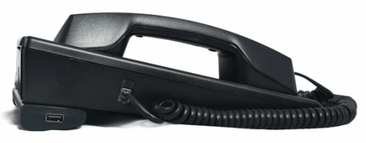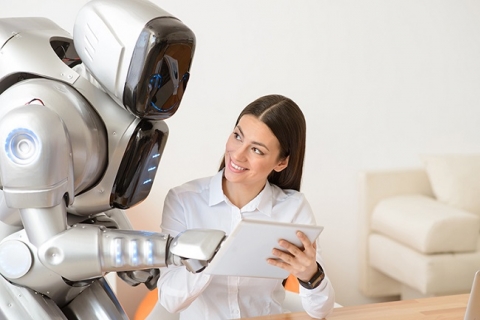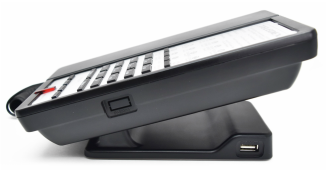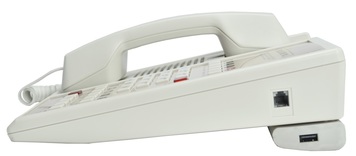Cetis eNewsletter
July 2016
Click on the Opt-In button to subscribe to receive the Cetis eNewsletter via email. Click here to browse the Cetis eNewsletter archive.
Design sells.
Give your guests the elegance that they deserve.

Interior designers appreciate the sophisticated flat panel, pedestal design of Teledex E Series USB hotel phones that complement flat screen televisions, and contemporary appliances in room.
Engineered specifically for hospitality applications, E Series USB phones are designed to give your guests the elegance they deserve, and are now available with built-in USB charging ports.
Amazingly big on features, yet surprisingly small in size. Teledex E Series hotel phones are 40% smaller than standard guest room telephones, creating an entirely new category in hotel telephone design. E Series flat panel, compact style adds a touch of elegance to any room without compromising functionality.
Originally styled to meet the limited space and energy requirements aboard cruise ship cabins, E Series micro-footprint hotel phones require minimal surface area on the desk and nightstand. Interior designers appreciate the sophisticated extra thin, ultra-stylish body while guests enjoy the familiar, comfortable feel of a sleek, modern handset.
Engineered specifically for hospitality applications, E Series USB phones are designed to give your guests the elegance they deserve, and are now available with built-in USB charging ports.
Amazingly big on features, yet surprisingly small in size. Teledex E Series hotel phones are 40% smaller than standard guest room telephones, creating an entirely new category in hotel telephone design. E Series flat panel, compact style adds a touch of elegance to any room without compromising functionality.
Originally styled to meet the limited space and energy requirements aboard cruise ship cabins, E Series micro-footprint hotel phones require minimal surface area on the desk and nightstand. Interior designers appreciate the sophisticated extra thin, ultra-stylish body while guests enjoy the familiar, comfortable feel of a sleek, modern handset.
|
E Series phones feature patented OneTouch voice mail technology for hands-free auto-dialing and retrieval, up to 12 guest service keys, and customizable faceplates. E Series is available in single and two-line, analog, VoIP, corded, and cordless configurations with or without built-in USB charging ports.
Give your guests the elegance that they deserve, and advance your guest room design footprint to the next level. Click here to request an E Series USB quotation, or here to arrange a consultation. |
USB charging for your existing room phones.
Guests are bringing multiple smart mobile devices into the guest room. Are you ready?

Teledex USB Series universal charging stations provide an easy, guest-friendly upgrade. Help ensure a positive guest experience, when you add the convenience of USB charging to your Teledex, TeleMatrix, Scitec, or competitive brand phone with USB Series universal USB charging stations.
Easy to install.
No need to unplug your room phone, or get out a screwdriver or pliers. Simply release the convenient adhesive strip and place the UCD100 charging station beneath your in-service room phone, plug in the wall adapter, and your guests are ready to charge their smart mobile devices via two built-in USB ports...one on either side of the unit.
Choose Black or Ash.
Whether you have already upgraded to contemporary Black phones, or prefer the classic Ash look, you may choose the USB Series color that meets your requirements. Select UCD100B for Black or UCD100A for Ash orders. Click here for USB Series product and ordering details, or here to request a consultation.
Easy to install.
No need to unplug your room phone, or get out a screwdriver or pliers. Simply release the convenient adhesive strip and place the UCD100 charging station beneath your in-service room phone, plug in the wall adapter, and your guests are ready to charge their smart mobile devices via two built-in USB ports...one on either side of the unit.
Choose Black or Ash.
Whether you have already upgraded to contemporary Black phones, or prefer the classic Ash look, you may choose the USB Series color that meets your requirements. Select UCD100B for Black or UCD100A for Ash orders. Click here for USB Series product and ordering details, or here to request a consultation.
Cetis is reliable.
Reliable: able to be trusted to do or provide what is needed: able to be relied on.

Cetis hotel phones have a proven record of reliability. In fact, we maintain a consistently low .002% out-of-box (OTB) failure rate across our entire model range.
Just in case you do have a support or OTB issue, however, we're available to help with Cetis customer service, IT trouble-shooting, return warranty authorization (RMA), and more.
Need assistance now? Click here for the Cetis Concierge, or here to visit our Support page. We look forward to supporting your hotel phone requirements globally.
Just in case you do have a support or OTB issue, however, we're available to help with Cetis customer service, IT trouble-shooting, return warranty authorization (RMA), and more.
Need assistance now? Click here for the Cetis Concierge, or here to visit our Support page. We look forward to supporting your hotel phone requirements globally.
Hotel-Online News
Robots: Coming soon to a hotel near you?
From hotel lobbies to restaurant floors, robots have started servicing customers’ basic requests.
 Image credit: Shutterstock
Image credit: Shutterstock
by Natalie Holmes -- In March, Spencer began escorting lost travelers to their gates at Amsterdam’s Schiphol Airport. That same month, robot hosts welcomed visitors to big trade shows like ITB in Berlin while the Hilton McLean Virginia in Washington, D.C, welcomed Connie the robotic concierge. Then there’s the robotic receptionist at Belgium’s Ghent Marriott. Not only can Mario speak 19 languages, he does so while dancing to Michael Jackson.
While these may have a certain novelty factor for now, it’s behind the scenes where artificial intelligence will really shake up the hospitality industry. According to the European Commission, the market for service robots will reach €100 billion a year by 2020.
“From our point of view there are two elements to robotics,” says Richard Pemberton, hospitality consultant with Avenue9, part of JLL Group. “There’s the side you can see and touch, and then there’s the processing that happens behind the scenes.” “Similarly, the goals of the technology are twofold,” he says. “On the one hand to improve operations, and on the other to control costs, through increased efficiency, for example, or higher sales.” US-based fast-food restaurant franchise Zaxby’s have been employing robotics to do both. Known as Hyperactive Bob, the unseen robot reduces waste and waiting times by scanning the parking lot for incoming cars while taking into account various data such as time of day and amount of hot food ready at a given moment. “The algorithmic system senses demand based on customer arrivals and makes predictions that feed into planning,” explains Pemberton. “This allows staff to adjust the timing of the cooking process, and respond to specific directions that speed up service, and thus turnover.”
A fledgling robotics marketplace
Currently, front-of-house robots are able to carry out rudimentary functions, such as checking guests in or recommending local restaurants. “You wouldn’t replace your concierge with a Connie—not just yet anyway,” says Pemberton. “Hotels should be trying to engage people with a product that works alongside the human team, as opposed to replacing it.” Nua Robotics, for example, have produced a suitcase that follows you around. “It works using Bluetooth and cameras to detect where you are,” explains Pemberton. “Hotels could adopt the technology to track guests’ luggage.” Similarly, Savioke’s Relay can learn the layout of a hotel and deliver items to guests on demand. Though not quite ready to offer full room service (the Relay can’t carry hot food), the autonomous android is already being employed by hotels, like Starwood’s Aloft group, who have named their new staff-member Botlr. Such robots, whether they’re making deliveries or welcoming guests, have been well received by the public. “The feedback I saw at CeBIT this year was really positive,” said Pemberton. But it’s the crossover of front-facing robots and back-end artificial intelligence that has the potential to transcend the novelty factor. “AI is where we’re going. Once we’ve perfected that side of things, it’ll be a huge boon to this industry.” Click here to read the entire article at Hotel-Online.
While these may have a certain novelty factor for now, it’s behind the scenes where artificial intelligence will really shake up the hospitality industry. According to the European Commission, the market for service robots will reach €100 billion a year by 2020.
“From our point of view there are two elements to robotics,” says Richard Pemberton, hospitality consultant with Avenue9, part of JLL Group. “There’s the side you can see and touch, and then there’s the processing that happens behind the scenes.” “Similarly, the goals of the technology are twofold,” he says. “On the one hand to improve operations, and on the other to control costs, through increased efficiency, for example, or higher sales.” US-based fast-food restaurant franchise Zaxby’s have been employing robotics to do both. Known as Hyperactive Bob, the unseen robot reduces waste and waiting times by scanning the parking lot for incoming cars while taking into account various data such as time of day and amount of hot food ready at a given moment. “The algorithmic system senses demand based on customer arrivals and makes predictions that feed into planning,” explains Pemberton. “This allows staff to adjust the timing of the cooking process, and respond to specific directions that speed up service, and thus turnover.”
A fledgling robotics marketplace
Currently, front-of-house robots are able to carry out rudimentary functions, such as checking guests in or recommending local restaurants. “You wouldn’t replace your concierge with a Connie—not just yet anyway,” says Pemberton. “Hotels should be trying to engage people with a product that works alongside the human team, as opposed to replacing it.” Nua Robotics, for example, have produced a suitcase that follows you around. “It works using Bluetooth and cameras to detect where you are,” explains Pemberton. “Hotels could adopt the technology to track guests’ luggage.” Similarly, Savioke’s Relay can learn the layout of a hotel and deliver items to guests on demand. Though not quite ready to offer full room service (the Relay can’t carry hot food), the autonomous android is already being employed by hotels, like Starwood’s Aloft group, who have named their new staff-member Botlr. Such robots, whether they’re making deliveries or welcoming guests, have been well received by the public. “The feedback I saw at CeBIT this year was really positive,” said Pemberton. But it’s the crossover of front-facing robots and back-end artificial intelligence that has the potential to transcend the novelty factor. “AI is where we’re going. Once we’ve perfected that side of things, it’ll be a huge boon to this industry.” Click here to read the entire article at Hotel-Online.
Cetis is fluent.
Looking for a hotel phone supplier that speaks your language?
Visit with us on LiveChat!

Did you know that you can receive online assistance with product, pricing, support of Cetis hotel phones? The Cetis Account Manager team is here to help you with any hotel phone-related questions that you may have – before, during, or after your purchase. You may find the LiveChat feature on the lower right side of our Cetis, Teledex, TeleMatrix, and Scitec websites. We look forward to chatting with you!





